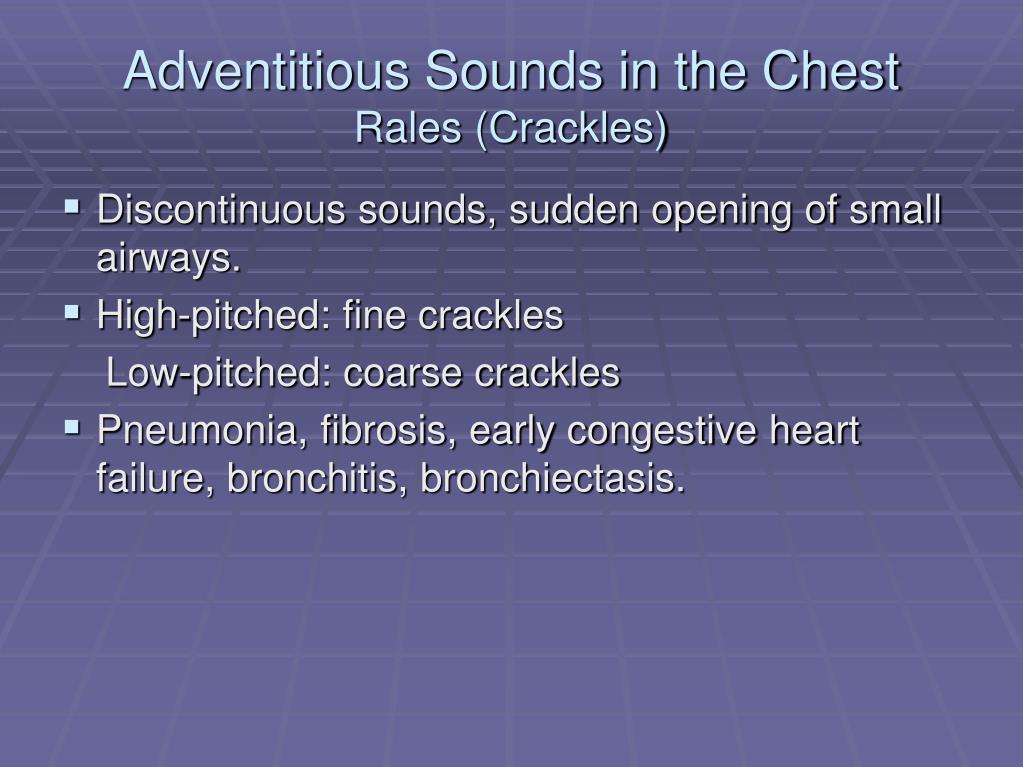

Coarse crepitation may be caused by inflammatory or noninflammatory arthritis. Fine crepitation often is palpable over joints involved by chronic inflammatory arthritis and usually indicates roughening of the opposing cartilage surfaces as a result of erosion or the presence of granulation tissue.
#Rales lung sounds manual#
Crepitation occurs when roughened articular or extra-articular surfaces are rubbed together by active motion or by manual compression. This sensation may or may not be accompanied by discomfort. Hunder, in Kelley's Textbook of Rheumatology (Ninth Edition), 2013 CrepitationĬrepitation is a palpable or audible grating or crunching sensation produced by motion. Expiratory crackles are much less frequent than inspiratory crackles and are often seen in obstructive lung disease. Coughing or deep inspiration may change the quality of coarse crackles, such as those associated with underlying alveolar or airway disease, but the crackles rarely disappear entirely. 85 Thus crackles heard later in inspiratory time imply that the tension required to open individual airways is greater. As inspiration progresses, radial traction on airway walls increase until suddenly they pop open. 86 This suggests that more tension is required to open individual airways in fibrosis than in lungs with secretions or edema. In a study by Pürilä and colleagues, 86 the crackles of pulmonary fibrosis began at 45% of inspiration, whereas those of nonfibrotic lung conditions were heard earlier: COPD at 25%, bronchiectasis at 33%, and heart failure at 37% of inspiration. Nath and Capel 85 have shown that late-inspiratory crackles are more often found in restrictive than obstructive lung disease. The timing of crackles is also important. After several such breaths or intentional coughing, these fine crackles will disappear if the small airways remain open throughout the time the patient is being examined. Crackles therefore are best heard during the first deep breaths at the lung bases posteriorly.

This is also compatible with the presence of crackles in healthy elderly persons in whom dependent airways close at resting lung volumes. 79,84 This explains why fine crackles are much more common during inspiration than during expiration and why they are best heard over dependent lung regions-where airways are more likely to close-than over uppermost regions. There is general agreement that the brief recurrent detonations that characterize fine crackles are caused by the explosive openings of small airways that had closed owing to the surface forces within them.
#Rales lung sounds series#
Murray MD, in Murray and Nadel's Textbook of Respiratory Medicine (Sixth Edition), 2016 Discontinuous Sounds (Crackles)Ĭrackles, still often referred to as “rales” in the United States and “crepitations” in Great Britain, consist of a series of short, explosive, nonmusical sounds that punctuate the underlying breath sound fine crackles ( Audio 16-4 ) are softer, shorter in duration, and higher in pitch than coarse crackles ( Audio 16-5).

If crackles are absent when upright but appear either when supine or with legs elevated, the test is positive (i.e., the patient has posturally induced crackles). 72 The clinician listens only after the patient has been in each position for 3 minutes. To elicit the finding, the clinician listens to the lower chest wall near the posterior axillary line with the patient in three sequential positions: sitting, supine, and supine with legs elevated 30 degrees.

The finding posturally induced crackles, which may have significance after myocardial infarction (see the section on Clinical Significance, later), describes crackles that appear in the supine position but disappear in the sitting position. 54 Many American clinicians still use the word rale as a synonym for crackle, although British clinicians more often use crackle. Crackles that appear early during inspiration and do not continue beyond mid-inspiration are called early inspiratory crackles those that continue into the second half of inspiration are called late inspiratory crackles. There are coarse crackles, which are loud, low pitched, and fewer in number per breath, and fine crackles, which are soft, higher pitched, and greater in number per breath. Steven McGee MD, in Evidence-Based Physical Diagnosis (Fourth Edition), 2018 1 CracklesĬrackles are discontinuous sounds, resembling the sound produced by rubbing strands of hair together in front of the ear or by pulling apart strips of Velcro.


 0 kommentar(er)
0 kommentar(er)
